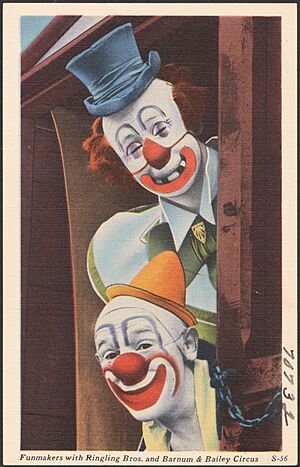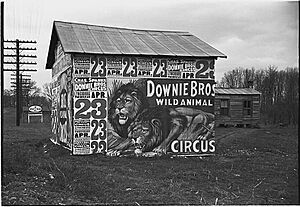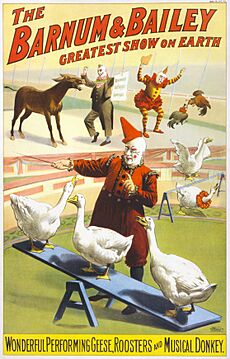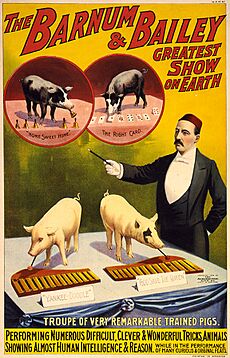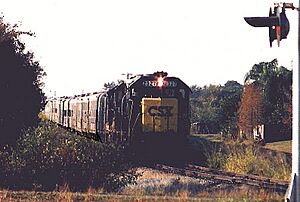- This page was last modified on 13 June 2025, at 18:28. Suggest an edit.
Ringling Bros. and Barnum & Bailey Circus facts for kids
| Ringling Bros. and Barnum & Bailey Circus | |
|---|---|
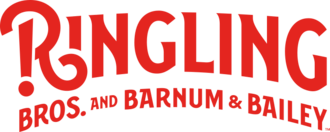
The Ringling Bros. and Barnum & Bailey Circus logo from the 2020s.
|
|
| Origin | |
| Country | United States |
| Founder(s) | |
| Year founded | 1871 |
| Information | |
| Operator(s) | Feld Entertainment |
| Ringmaster(s) | Jonathan Lee Iverson |
| Traveling show? | Yes |
| Circus tent? | No (post-1957) |
| Winter quarters | Ellenton, Florida, U.S. |
The Ringling Bros. and Barnum & Bailey Circus is a famous American traveling circus. It is often called "The Greatest Show on Earth." This circus and its earlier versions have been putting on shows since 1871. It took a break from 2017 to 2023.
The circus we know today started in 1919. This was when the Barnum & Bailey's Greatest Show on Earth joined with the Ringling Bros. World's Greatest Shows. P. T. Barnum and James Anthony Bailey created the Barnum & Bailey circus. The Ringling brothers bought Barnum & Bailey Ltd. in 1907. They bought it after James Anthony Bailey died in 1906. But they kept the two circuses separate until they merged in 1919.
After 1957, the circus stopped using its own large tents, called "big tops." Instead, it performed in big buildings like sports stadiums. In 1967, Irvin Feld and his brother Israel bought the circus. They bought it from the Ringling family with help from Houston judge Roy Hofheinz. In 1971, the Felds and Hofheinz sold the circus to Mattel, a toy company. But they bought it back from Mattel in 1981. After Irvin Feld passed away in 1984, his son Kenneth Feld took over. The circus is still part of Feld Entertainment, a large entertainment company. Its main office is in Ellenton, Florida.
In May 2017, the circus performed its last show with animals. This happened at Nassau Veterans Memorial Coliseum. The circus closed for a while because fewer people were buying tickets. Also, many people were protesting about how animals were treated. Plus, it cost a lot of money to run the show.
In May 2022, after five years, Feld Entertainment announced good news. The circus would start touring again in the fall of 2023. This time, there would be no animals in the shows.
Contents
The Circus Story: How It Began
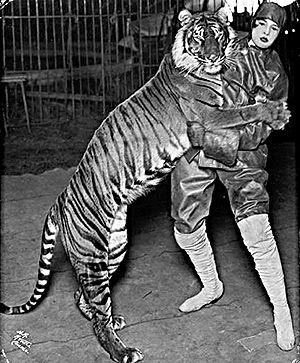
A Bali tiger with its trainer in Ringling Bros around 1915.
|
Early American Circuses
Hachaliah Bailey started one of the first circuses in the United States. He bought an African elephant named "Old Bet" around 1806. This was just 13 years after John Bill Ricketts brought the circus to the U.S. from Great Britain.
P. T. Barnum worked as a ticket seller for Hachaliah Bailey's show when he was a boy. Later, Barnum opened Barnum's American Museum in New York City in 1841. He added animals to make it like a zoo. He also had a freak show with unusual people. Barnum took his museum on tours, calling it "P.T. Barnum's Grand Traveling American Museum." His museum burned down in 1865 and again in 1868. After that, Barnum decided to stop the museum business.
In 1871, Dan Castello and William Cameron Coup convinced Barnum to return. They wanted him to help with a circus they had started in Delavan, Wisconsin. Their show was named "P.T. Barnum's Great Traveling Museum, Menagerie, Caravan, and Hippodrome." Barnum thought it was "truly immense" and could be "The Greatest Show on Earth." This phrase later became part of the circus's name.
Barnum and Bailey Join Forces
At the same time, James Anthony Bailey had started his own circus with James E. Cooper. It was called the Cooper and Bailey Circus. This circus became a big rival to Barnum's show. Bailey's circus was doing very well. So, Barnum decided to combine their shows. They agreed to merge on March 28, 1881.
Their combined show was first called "P.T. Barnum's Greatest Show On Earth, And The Great London Circus, Sanger's Royal British Menagerie and The Grand International Allied Shows United." Luckily, it was later shortened to "Barnum and Bailey's Circus." Bailey helped get Jumbo, who was advertised as the world's largest elephant.
After Jumbo died, Barnum gave his stuffed body to Tufts University. Barnum was one of the first trustees there. The Barnum Museum of Natural History opened at Tufts in 1884, and Jumbo was a main attraction. Even today, the Tufts athletic teams are called the "Jumbos." Barnum died in 1891. Bailey then bought the circus from Barnum's wife. Bailey toured the Eastern United States and then took his circus to Europe from 1897 to 1902.
The Ringling Brothers Rise
Separately, in 1884, five of the seven Ringling brothers started a small circus in Baraboo, Wisconsin. This was when Barnum & Bailey were very popular. Like many small circuses back then, the brothers moved their show from town to town using animal-drawn wagons. Their circus grew quickly. Soon, they could move their circus by train. This made it the biggest traveling entertainment business of its time.
Bailey's European tour gave the Ringling brothers a chance to bring their show from the Midwest to the East Coast. Facing this new competition, Bailey took his show west of the Rocky Mountains for the first time in 1905. He died the next year, and the Ringling Brothers bought his circus.
The Greatest Show on Earth is Born
The Ringlings bought the Barnum & Bailey Greatest Show on Earth in 1907. They ran the two circuses separately until 1919. By then, Charles Edward Ringling and John Nicholas Ringling were the only two brothers left. They decided it was too hard to run two separate circuses. This was because of fewer workers and problems with train travel during World War I. So, on March 29, 1919, the "Ringling Bros. and Barnum & Bailey Combined Shows" started in New York City. Posters announced that the two great shows were now "combined into one record-breaking giant of all exhibitions." Charles E. Ringling died in 1926, but the circus did very well during the 1920s.
John Ringling moved the circus headquarters to Sarasota, Florida, in 1927.
In 1929, John Ringling bought the American Circus Corporation for $1.7 million. This company owned five other circuses.
In 1938, the circus offered a lot of money to Frank Buck. He was a famous adventurer and animal collector. They wanted him to be their star and ride an elephant into the show. He refused to join the American Federation of Actors union. He said he was "a scientist, not an actor." Even though there was a threat of a strike, he stuck to his beliefs. The union eventually gave Buck special permission to introduce Gargantua the gorilla without joining.
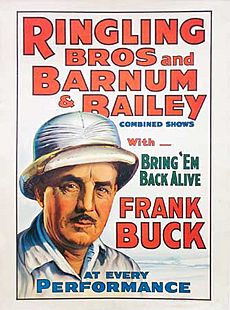
Frank Buck, a star attraction in 1938.
The circus faced challenges during the 1930s because of the Great Depression. But it managed to stay open. After John Nicholas Ringling died, his nephew, John Ringling North, managed the circus. He did this twice, first from 1937 to 1943. President Roosevelt gave the circus special permission to use trains in 1942. This was despite travel rules during World War II. Many famous circus pictures were taken by American photographer Maxwell Frederic Coplan. He traveled with the circus, showing its beauty and its tough parts.
North's cousin Robert became president of the show in 1943. North returned as president in 1947.
The Hartford Circus Fire
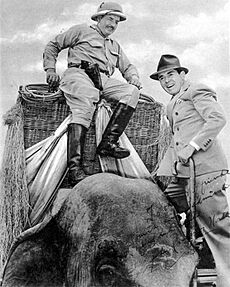
John Ringling North (right) and Frank Buck, a featured attraction in 1938.
On July 6, 1944, a terrible fire happened in Hartford, Connecticut. It was during an afternoon show with about 8,000 people. The main tent, called the Big Top, caught fire. At least 167 people died, and hundreds more were hurt. The circus leaders were found to be at fault. Several Ringling executives went to jail. The circus management used all their profits for the next ten years. This money went to pay claims from the City of Hartford and the fire survivors.
The Feld Family Takes Over
After World War II, other parts of the country did well, but the circus struggled. Fewer people came to shows, and costs went up. Movies and television became more popular. The circus gave its last show under the big top tent in Pittsburgh, Pennsylvania, on July 16, 1956. A magazine called Life said that "a magical era had passed forever." In 1956, John Ringling North and Arthur Concello moved the circus indoors. Irvin Feld was one of the people hired to help promote shows in certain cities. Irvin and his brother, Israel Feld, were already known for promoting rock and roll shows in the Washington D.C. area. In 1959, Ringling Bros. started spending winters in Venice, Florida.
In late 1967, Irvin Feld, Israel Feld, and Judge Roy Mark Hofheinz bought the circus. They paid $8 million to North and the Ringling family. Irvin Feld immediately made changes to make the show better and more profitable. He removed the freak show. He wanted the circus to be more family-friendly and not make money from people's differences. He also got rid of some common acts.
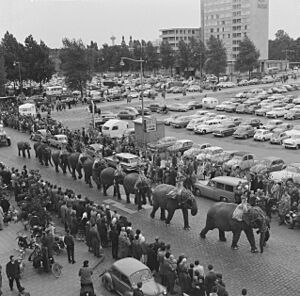
Circus Williams's elephants arriving in Rotterdam in 1961.
In 1968, Feld noticed that clowning skills were not being taught enough. Many clowns were getting older. So, he started the Ringling Bros. and Barnum & Bailey Clown College. He also bought a European circus called Circus Williams for $2 million. He did this just to get their star animal trainer, Gunther Gebel-Williams. Feld then split the show into two touring groups, called Red and Blue. These groups could travel across the country separately. This also meant people could see different acts and themes if they saw both tours. Also in 1968, Feld hired The King Charles Troupe. This was a unicycle club from The Bronx. They were the first African-American circus group. They performed unicycle basketball for 18 years with the circus.
The company became a public company in 1969. In 1970, Feld's only son Kenneth joined the company. He became a co-producer. The circus was sold to the Mattel toy company in 1971 for $40 million. The Feld family stayed on to manage it.
After Walt Disney World opened near Orlando, Florida, in 1971, the circus tried to attract tourists. They planned to open Circus World theme park in nearby Haines City. Construction started in April 1973. The park was meant to be the circus's winter home and have the Clown College there. Mattel decided to sell the circus company in December 1973. This was despite the circus making money, because Mattel had lost $29.9 million in 1972. The park's opening was delayed until February 1974.
In January 1974, Venture Out in America, Inc., bought the combined shows. This company was part of Gulf Oil. The opening was pushed back again to 1975. The Circus Showcase for Circus World opened on February 21, 1974. But Venture Out put the purchase deal back into talks. The opening of the main complex was moved to early 1976.
In the 1980s, Ringling sued the American Broadcasting Company. This was because ABC aired a Schoolhouse Rock! episode called "The Greatest Show On Earth." The circus's slogan was used as the title.
By May 1980, the company grew to three circuses. They added the one-ring International Circus Festival of Monte Carlo. This show first appeared in Japan and Australia. The Felds bought the circus back in 1982, but not Circus World. Irvin Feld died in 1984. Since then, his son Kenneth has run the company.
In 1990, the Seminole Gulf Railway could no longer support the circus's train cars. So, the circus moved its winter home to the Florida State Fairgrounds in Tampa. In 1993, the clown college moved from Venice Arena to Baraboo, Wisconsin. In 1995, the company started the Center for Elephant Conservation (CEC).
After three years in Baraboo, the clown college moved to the Sarasota Opera House in Sarasota. It stayed there until 1998, when the program stopped. In February 1999, the circus company started a new show called Barnum's Kaleidoscape. This was a smaller, one-ring circus performed in a tent. It was meant to compete with fancy circuses like Cirque du Soleil. But Barnum's Kaleidoscape was not successful. It stopped performances at the end of 2000.
Nicole Feld became the first female producer of Ringling Circus in 2004. In 2009, Nicole and Alana Feld worked together to produce the circus. In 2001, a group led by The Humane Society of the United States sued the circus. They claimed the elephants were mistreated. The lawsuit and a countersuit ended in 2014. The circus won $25.2 million in settlements. In March 2015, the circus announced that all elephants would retire to the CEC by 2018. But Ringling changed its mind and retired the elephants earlier, in May 2016.
Eight months after the elephants retired, the circus made a big announcement in January 2017. It would do 30 more shows and then close. More than 462 employees would lose their jobs between March and May 2017. The circus said ticket sales dropped a lot after the elephants left. Also, running the show was very expensive. People's concerns about animal treatment were also a reason. On May 7, 2017, its "Circus Extreme" tour had its last show at the Dunkin' Donuts Center in Providence, Rhode Island. The circus's very last show before its break was its "Out of This World" tour. This happened at Nassau Veterans Memorial Coliseum in Uniondale, New York, on May 21, 2017.
The Circus Returns: 2023 Relaunch
In October 2021, Kenneth Feld and Juliette Feld Grossman announced exciting news. The circus would return in 2023, but without animal performances. On September 29, 2023, after six years, the new circus began its tour. It kicked off at Brookshire Grocery Arena in Bossier City, Louisiana.
Circus Trains: Moving the Show
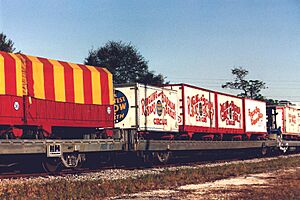
A circus train rolling through Safety Harbor, Florida.
The circus used two shows that traveled by circus train. One was for the Red Unit, and one for the Blue Unit. Each train was about a mile long. They had around 60 cars. This included 36 passenger cars, 4 cars for animals, and 20 freight cars. The circus's train cars had the special mark "RBBX." The Blue and Red Tours put on a full three-ring show for two years each. They took December off. They visited different big cities each year.
Each train presented a different "edition" of the show. The numbering started from the circus's beginning in 1871. The Blue Tour showed the even-numbered editions. It started each even-numbered year. The Red Tour showed the odd-numbered editions. It started each odd-numbered year.
In the 1950s, there was one huge train system. It had three separate train loads that brought the main show to big cities. The first train had 22 cars. It carried the tents and the workers to set them up. The second section had 28 cars. It carried the canvasmen, ushers, and sideshow workers. The third section had 19 sleeping cars for the performers.
On January 13, 1994, a circus train derailed. It was going from St. Petersburg to Orlando. This happened about four miles south of Lakeland. Several of the 150 to 200 people on the train were hurt. Two people died: clown Ceslee Conkling and elephant trainer Ted Svertesky. The circus animals were shaken but not injured. The heavier horses and elephants were in the front cars. Lions, tigers, bears, and other animals were at the back.
From 2003 to 2015, the circus also had a Gold Tour. This show traveled by truck. It was a smaller, single-ring version of the show. It was made for smaller towns that couldn't host the big three-ring shows.
The Circus on Screen
In 1952, Paramount Pictures released a movie called The Greatest Show on Earth. This film, made by Cecil B. DeMille, showed the circus traveling. It followed the setup and take-down of performances during the 1951 season. The movie starred Charlton Heston, Betty Hutton, James Stewart, and Emmett Kelly. After it came out, the film won two Academy Awards, including Best Picture. A TV show with the same name was inspired by the movie. Jack Palance played a role similar to Charlton Heston's character. The show ran on ABC in 1963–1964 for thirty episodes.
In August 2011, 20th Century Fox announced a musical drama film. It was called The Greatest Showman. Michael Gracey was set to direct it. Jenny Bicks and Bill Condon wrote the script. Hugh Jackman played P.T. Barnum, and he also produced the film. Michelle Williams played Barnum's wife, Charity. Filming began in November 2016. The movie was released on December 20, 2017.
Auditions for the New Show
In early 2022, the circus started looking for new performers. They wanted artists for their updated show. More than 1,000 acts applied. Auditions were held in cities like Paris, Las Vegas, Ethiopia, and Mongolia.
In May 2022, Feld Entertainment announced that the circus would start again in the fall of 2023. It would tour 50 cities. The circus said the new show would be a "multi-platform entertainment franchise."
See also
- Barnum's Kaleidoscape
- William Washington Cole, a Barnum and Bailey business partner
- Barnum and Bailey's Favorite
- John Robinson Circus
Images for kids
-
A Ringling Bros Postage card, 1911

